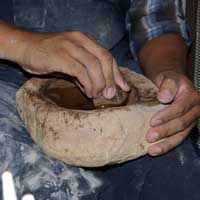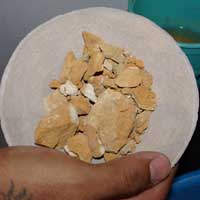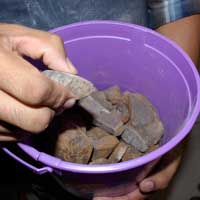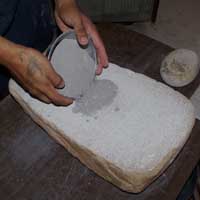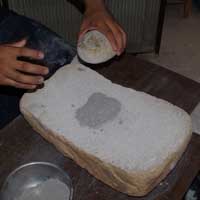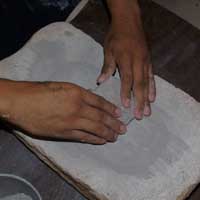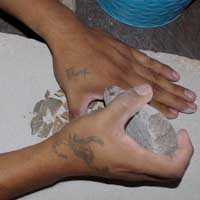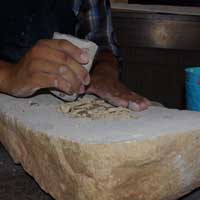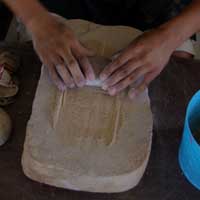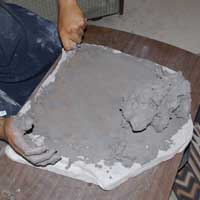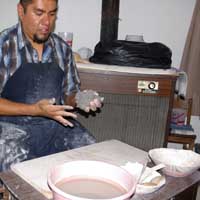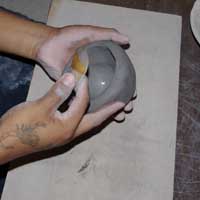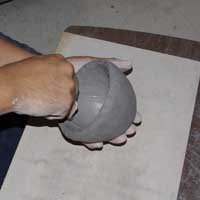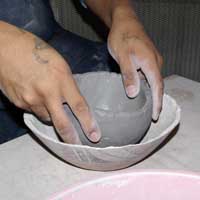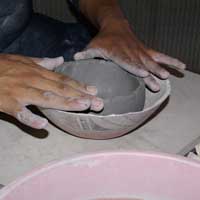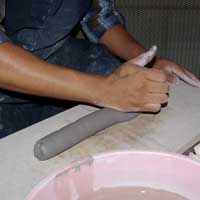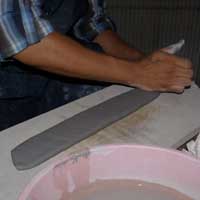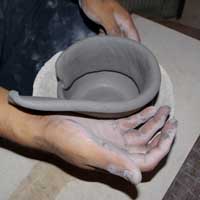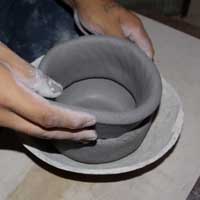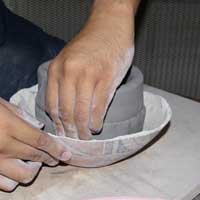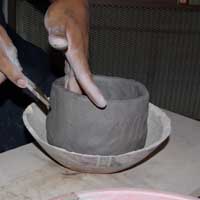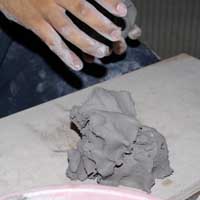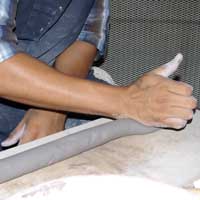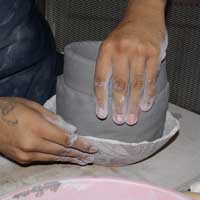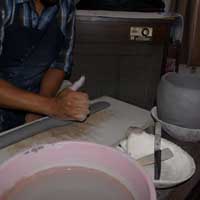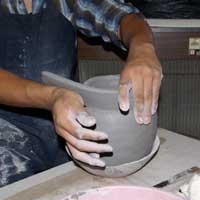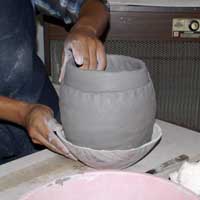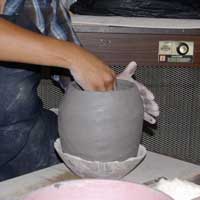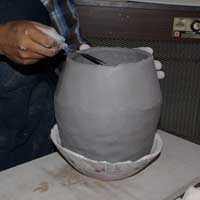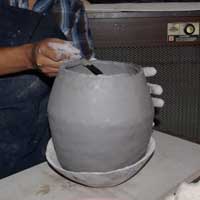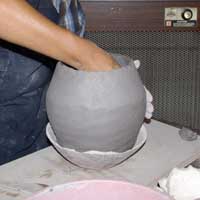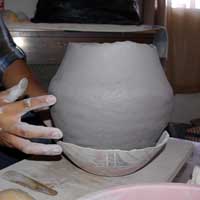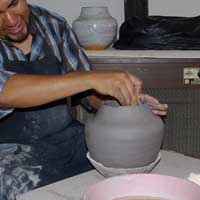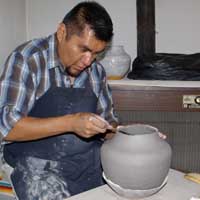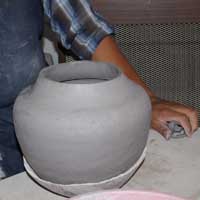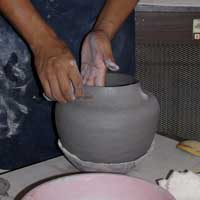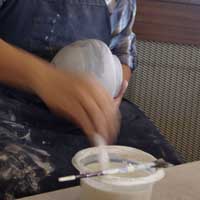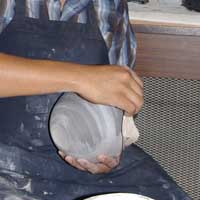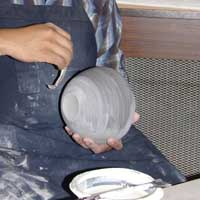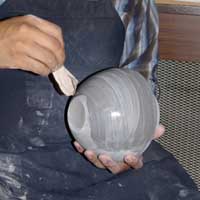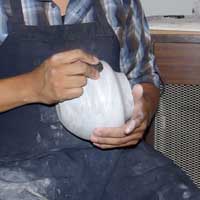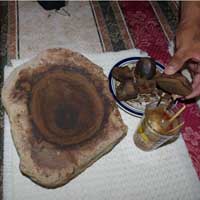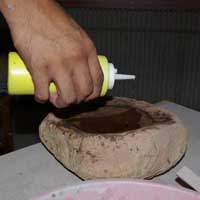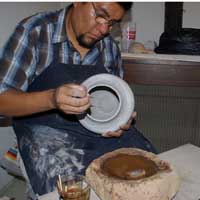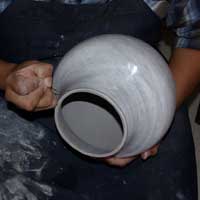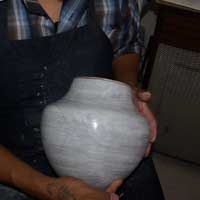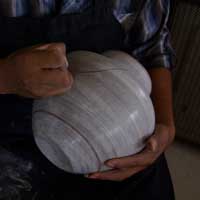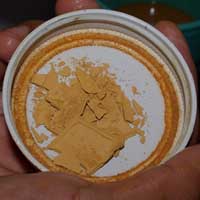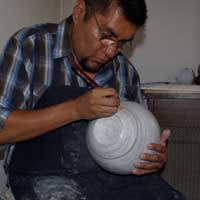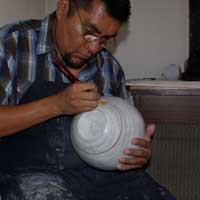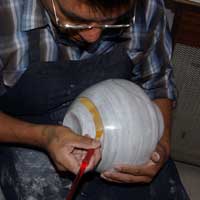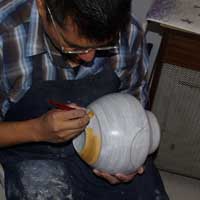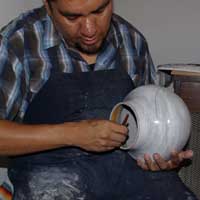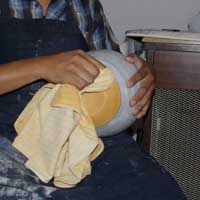The Process
So often people ask us, "How long does it take to make a piece of pottery?" In an attempt to answer this question we always tell people about the various steps of pottery making. We feel that pictures may be clearer than words. Illustrated here is the process of making an Acoma pot. We are indebted to Franklin Peters of Acoma pueblo who shared with us his time, material, skill, and good humor. His pottery can be seen here.
Click on any photo to enlarge!
![Clay in rock form]() The clay in raw rock form
The clay in raw rock form![Pottery shards used to temper the clay]() Old pottery shards for tempering the clay
Old pottery shards for tempering the clay![Raw Rock slip]() The white slip in raw rock form
The white slip in raw rock form![Yellow slip as rock]() The yellow slip in raw rock form
The yellow slip in raw rock form![Brown paint as rock]() The brown paint in raw rock form
The brown paint in raw rock form
![Tools used in the process]() Building tools consisting of gourds, knife, and wooden spatula
Building tools consisting of gourds, knife, and wooden spatula![Old pottery pieces for forms]() Old pieces of pottery used as a form to start the pot also called "Base Bowls"
Old pieces of pottery used as a form to start the pot also called "Base Bowls"![Yucca leavesa are used for paint brushes]() From right to left, the yucca soaking to soften, the yucca chewed to reveal fibers, the yucca trimmed and ready to use for painting
From right to left, the yucca soaking to soften, the yucca chewed to reveal fibers, the yucca trimmed and ready to use for painting
![Clay in rock form]() Clay in rock form
Clay in rock form![Clay soaking in a bin]() Clay soaking to break up the hard bits and to make it malleable in preparation for sun drying and coarse grinding
Clay soaking to break up the hard bits and to make it malleable in preparation for sun drying and coarse grinding![Grinding the clay]() Grinding the dry clay chunks into powder
Grinding the dry clay chunks into powder![Grinding the clay]() Grinding the dry clay chunks to powder
Grinding the dry clay chunks to powder![Grinding the clay]() Grinding the dry clay chunks to powder
Grinding the dry clay chunks to powder![Grinding the clay some more]() Grinding the dry clay chunks to powder
Grinding the dry clay chunks to powder![Grinding the clay yet finer]() Grinding the dry clay chunks to powder
Grinding the dry clay chunks to powder![Clay ground fine enough to use]() Clay ground to the correct fine consistency
Clay ground to the correct fine consistency![Ground clay going into a bowl]() Ground clay powder being put into bowl
Ground clay powder being put into bowl![Finely ground clay]() Finished dry ground clay
Finished dry ground clay![Pottery shards for tempering the clay]() Pottery shards used for tempering (adding additional structural support) the clay
Pottery shards used for tempering (adding additional structural support) the clay![Pottery shards for grinding]() Pottery shards to be ground
Pottery shards to be ground![Breaking up the pottery shards]() Pounding shards with a stone
Pounding shards with a stone![Grinding the pottery shards more]() Pounding shards finer with a stone
Pounding shards finer with a stone![Grinding pottery shards finer yet]() Pounding shards finer with a stone
Pounding shards finer with a stone![Pottery shards eventually become powder]() Grinding shards
Grinding shards![Enough grinding turns the shards to a fine powder]() Finished grinding shards to powder
Finished grinding shards to powder![The powdered clay gets poured on a mixing stone]() Pouring powdered clay on mixing stone which was handed down from his grandmother
Pouring powdered clay on mixing stone which was handed down from his grandmother![Ground pottery shards are then added to the clay powder]() Adding ground pottery shards
Adding ground pottery shards![Adding more ground pottery shards to the clay powder]() Adding ground pottery shards
Adding ground pottery shards![Hand mixing ground pottery shards into the clay powder]() Hand mixing powdered clay and powdered shards
Hand mixing powdered clay and powdered shards![The powder mix gets some water added]() adding water using traditional native big gulp cup
adding water using traditional native big gulp cup![The clay-water mix gets hand mixed]() Mixing water, clay, and shards
Mixing water, clay, and shards![The mix is scraped up with a wooden scraper]() Using wooden tool to scrape up every bit of clay
Using wooden tool to scrape up every bit of clay![Scraping up all the mixed clay is important]() Using wooden tool to scrape up every bit of clay
Using wooden tool to scrape up every bit of clay![To be usable, the clay must be formed iunto a block and stored overnight]() Forming the clay into a block to store it overnight to help it become more usable
Forming the clay into a block to store it overnight to help it become more usable
![Water, tools and <em>puki</em> ready]() Water, tools, and pottery bowl in place to begin forming
Water, tools, and pottery bowl in place to begin forming![A small bit of clay to begin with]() Starting with a small piece of clay
Starting with a small piece of clay![The clay gets worked to remove air bubbles]() Punching the clay repeatedly to remove air bubbles and forming into a bowl shape
Punching the clay repeatedly to remove air bubbles and forming into a bowl shape ![Forming the bowl shape]() Forming the clay into a bowl shape
Forming the clay into a bowl shape![Using a piece of a gourd to work the clay on the inside]() Using a gourd to work the clay outwards from the inside
Using a gourd to work the clay outwards from the inside![Using a piece of gourd to work the clay outwards]() Using a gourd to work the clay outwards from the inside
Using a gourd to work the clay outwards from the inside![Using a piece of gourd to work the clay out from the inside]() Using a gourd to work the clay outwards from the inside
Using a gourd to work the clay outwards from the inside![Placing the clay into the bowl form]() Placing the clay into the bowl form
Placing the clay into the bowl form![Pushing the clay into a bowl form]() Pushing the clay into the bowl form
Pushing the clay into the bowl form![Finished and ready for the first coil]() Finished clay in bowl form
Finished clay in bowl form![Preparing the first coil]() Preparing clay for the first coil
Preparing clay for the first coil![Pounding the clay to remove air bubbles]() Pounding the first coil with hand to flatten
Pounding the first coil with hand to flatten![Pounding the first coil flat]() Pounding the first coil with hand to flatten
Pounding the first coil with hand to flatten![Still flattening the clay]() Pounding the first coil with hand to flatten
Pounding the first coil with hand to flatten![The first flat coil]() Flattened clay coil
Flattened clay coil![Adding the first clay coil to the bowl]() Adding the clay coil to the bowl
Adding the clay coil to the bowl![Adding the fist clay coil to the bowl]() Adding the clay coil to the bowl
Adding the clay coil to the bowl![Adding the first clay coil to the bowl]() Adding the clay coil to the bowl
Adding the clay coil to the bowl![Smoothing the first clay coil]() Smoothing the added coil
Smoothing the added coil![Smoothing the first clay cloil to the bowl]() Smoothing the added coil
Smoothing the added coil![Smoothing the first clay coil]() Smoothing the added coil
Smoothing the added coil![Smoothing the first coil]() Smoothing the added coil
Smoothing the added coil![Preparing to make the second coil]() Preparing the clay for the second coil
Preparing the clay for the second coil![Rolling out the second coil]() Rolling the second coil
Rolling the second coil![Flattening the second coil]() Flattening the second coil
Flattening the second coil![Flattening the second coil]() Flattening the second coil
Flattening the second coil![Adding the second coil to the bowl]() Attaching the second coil
Attaching the second coil![Adding the second coil of clay]() Attaching the second coil
Attaching the second coil![Attaching the second coil to the bowl]() Attaching the second coil
Attaching the second coil![Smoothing the second coil]() Smoothing the second coil
Smoothing the second coil![Rolling out the third coil]() Rolling out the third coil
Rolling out the third coil![Flattening the third coil]() Flattening the third coil
Flattening the third coil![Attaching the third coil to the bowl]() Attaching the third coil
Attaching the third coil![Attaching the third coil]() Attaching the third coil
Attaching the third coil![Smoothing the third coil]() Smoothing the third coil
Smoothing the third coil![Smoothing the third coil to the pot]() Smoothing the third coil
Smoothing the third coil![Shaping the pot]() Shaping the pot
Shaping the pot![Shaping the pot]() Shaping the pot
Shaping the pot![Beginning the first trim]() The first trim
The first trim![Trimming the pot]() The first trim
The first trim![Stretching and shaping the pot from inside]() Stretching and shaping the pot
Stretching and shaping the pot![Shaping the pot from outside]() Stretching and shaping the pot
Stretching and shaping the pot![Stretching and shaping the pot]() Stretching and shaping the pot
Stretching and shaping the pot![Stretching and shaping the pot]() Stretching and shaping the pot
Stretching and shaping the pot![The second trim of the pot opening]() The second trim of the top of the pot
The second trim of the top of the pot![Trimming the pot]() Trimming the pot
Trimming the pot![Trimming the pot]() Trimming the pot
Trimming the pot![Trimming the pot]() Trimming the pot
Trimming the pot![The trimmed pot]() Trimmed pot
Trimmed pot![Final shaping of the neck]() Shaping the neck: You can view this finished piece
here
Shaping the neck: You can view this finished piece
here![Into the drying process]() Drying process: The piece on the left is the one from above, the one in the middle is a completely dried pot
Drying process: The piece on the left is the one from above, the one in the middle is a completely dried pot
![The white slip in original rock form]() The white slip in rock form
The white slip in rock form![Soajking the white slip]() The white slip soaking
The white slip soaking![Applying the white slip with a piece of cloth]() Applying White slip using a piece of cloth
Applying White slip using a piece of cloth![Using a cloth to apply the white slip]() Applying White slip using a piece of cloth
Applying White slip using a piece of cloth![Applying the white slip]() Applying White slip using a piece of cloth
Applying White slip using a piece of cloth![Final application of the white slip]() Applying White slip using a piece of cloth
Applying White slip using a piece of cloth
![Back to the drying process]() Drying process: The piece on the right is after the white slip has dried
Drying process: The piece on the right is after the white slip has dried![Polishing white a round river rock]() Polishing with round river stone
Polishing with round river stone![Polishing with a water-polished river stone]() Polishing with round river stone
Polishing with round river stone
![Brown paint in original rock form]() The brown paint in rock form
The brown paint in rock form![The brown paint grinding stone handed down from Franklin's grandmother]() The brown paint stone handed down from Franklin's grandmother
The brown paint stone handed down from Franklin's grandmother![Adding water to the brown paint stone]() Water added to the brown paint stone
Water added to the brown paint stone![Grinding the brown paint stone to achieve proper concentration of pigment]() Grinding the brown paint rock in the brown paint stone with water until the right concentration is achieved
Grinding the brown paint rock in the brown paint stone with water until the right concentration is achieved![Grinding more of the brown paint stone]() Grinding the brown paint rock in the brown paint stone with water until the right concentration is achieved
Grinding the brown paint rock in the brown paint stone with water until the right concentration is achieved![Adding processed bee-weed to the brown paint mix]() Grinding the processed bee weed into the ground brown paint rock and water until the correct amount has been added
Grinding the processed bee weed into the ground brown paint rock and water until the correct amount has been added![Painting brown with a yucca brush]() Painting brown with a yucca brush
Painting brown with a yucca brush![Using a yucca brush to paint brown]() Painting brown with a yucca brush
Painting brown with a yucca brush![Brown paint being applied with a yucca brush]() Painting brown with a yucca brush
Painting brown with a yucca brush![Adding brown paint with a yucca brush]() Painting brown with a yucca brush
Painting brown with a yucca brush![Painting with a yucca brush]() Painting brown with a yucca brush
Painting brown with a yucca brush![Using a yucca brush to add brown paint]() Painting brown with a yucca brush
Painting brown with a yucca brush![Orange slip in original rock form]() Orange slip in rock form
Orange slip in rock form![Soaking the orange slip]() The orange slip soaking
The orange slip soaking![The orange slip dry]() The orange slip dried
The orange slip dried![Paint made of the orange slip]() The orange slip reconstituted into paint
The orange slip reconstituted into paint![Painting orange slip]() Painting yellow slip
Painting yellow slip![Painting orange slip with a yucca brush]() Painting yellow slip
Painting yellow slip![Adding orange paint with a yucca brush]() Painting yellow slip
Painting yellow slip![Painting orange paint with a yucca brush]() Painting yellow slip
Painting yellow slip![Painting with the orange paint]() Painting yellow slip
Painting yellow slip![Buffing the ornage paint]() Buffing the yellow paint
Buffing the yellow paint
Copyright © 1998-2025 by
Andrea Fisher Fine Pottery
All Rights Reserved.



